The concepts of head highs and body highs are two extremes of cannabis euphoria. The average stoner will tell you: “sativa strains give you head highs, and indica strains give body highs.”

Despite the rise in cannabis studies over the past two decades, there are still some parts that are a complete mystery to researchers. Below, we’ll take an in-depth look at head highs vs body highs.
Head highs are associated with high energy, euphoric, and energized feelings centralized in the head, while body highs are associated with relaxed, low energetic feelings and sensations throughout the body.
Table of Contents
A Deeper Look at Head Highs and Body Highs
We’re taking a Weediokia deep dive on the difference between head highs and body highs. We’ll be dispelling myths and looking at the current science, and hopefully, by the end of the article, you’ll understand the fundamentals of getting baked.
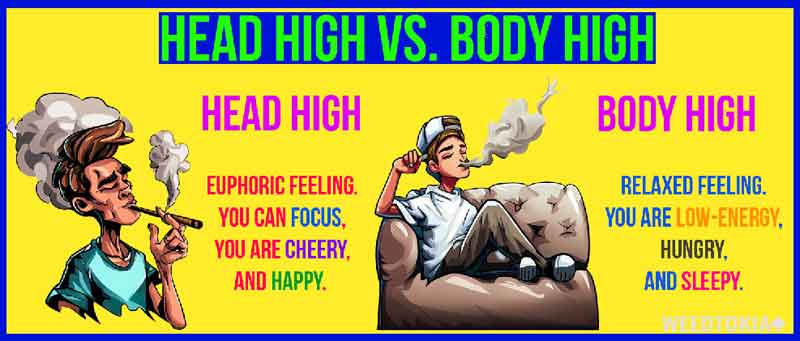
For those of you who are new to the world of cannabis, let’s begin by explaining the difference between these two manifestations of a cannabis high.
Head Highs
Head highs or “cerebral highs” refer to a more energetic expression of cannabis euphoria. Typically, you’re filled with energy, able to focus, cheery, happy, and just on top of the world. Consumers call it a “head high” because most of the euphoria feels like it’s converging in your head.
Body Highs
Body highs are expressed with a deep sense of relaxation, low energy, elevated hunger, sleepiness, calmness, and an almost ‘narcotic’ feeling. You feel “Doped,” as if you’re on some sort of pain medication. Thick in the head and thick in the body.
Head highs are typically associated with Sativa Strains, which are also sometimes called “daytime strains.” Indicas, on the other hand, are more closely associated with Body Highs and are considered “nighttime strains.”
It doesn’t take a rocket scientist to figure out why the day/night labels were assigned to both experiences. If you were to walk into a dispensary, most Budtenders would use these metrics to explain the strains they have on display.
While this is the general wisdom on the street, science has looked into this phenomenon and essentially said, “Hold the Phone; it’s not that simple!”
Here is a good video that also describes the differences between a head high and body high if you’re interested in watching. They don’t go as much into the technicals, but they do describe how differences in how you’ll feel.
Indica and Sativa Effects on Highs
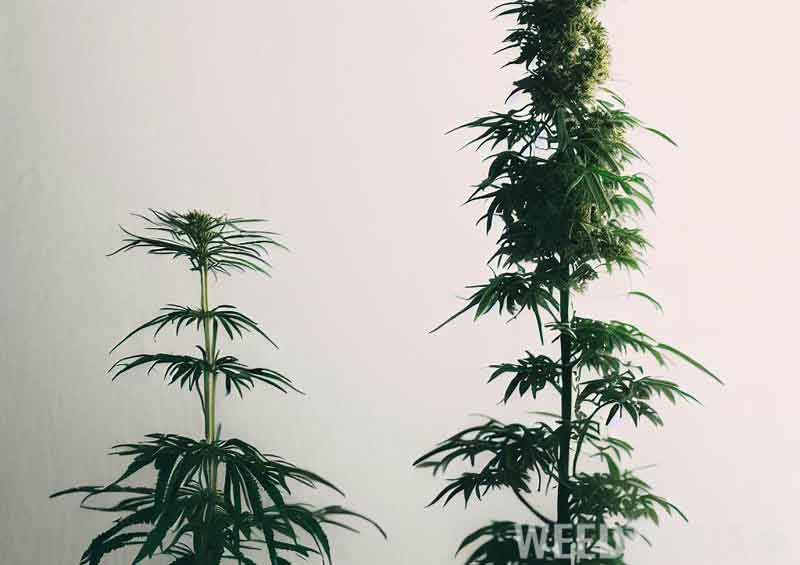
Many people are aware of the concept of indica and sativa plants. It is typically explained that Sativas have taller, thinner leaf structures and are associated with “head highs.” Whereas Indicas are considered to be shorter, bushier plants with thick leaf structures and associated with “body highs.”
The problem with this assumption, however, is that it’s not true.
Yes, indica and sativas do exist; they are called “phenotypes.” Ruderalis is the third phenotype.
However, whether Sativas predominantly give you a head high or Indicas give you a body high is still up for debate. Furthermore, the fact that most of the strains you can purchase these days are hybrids also means that these clear distinctions are muddied.

Firstly, when looking at the genetic makeup of Sativas and Indicas, researchers discovered that genetically speaking, “there was a strong statistical support dividing the samples into two genetic groups, the groups did not correspond to commonly reported Sativa/Hybrid/Indica types.”
In other words, while there are differences between strains, a “would be sativa strain” could provide you with a body high, and an “indica” could generate a head high.
Yet, since the concepts of Sativas, Indicas, and Hybrids are entrenched within the culture, retailers continue to push these labels, and consumers continue to accept them.
How High Will You Get? Use Smells As An Indicator
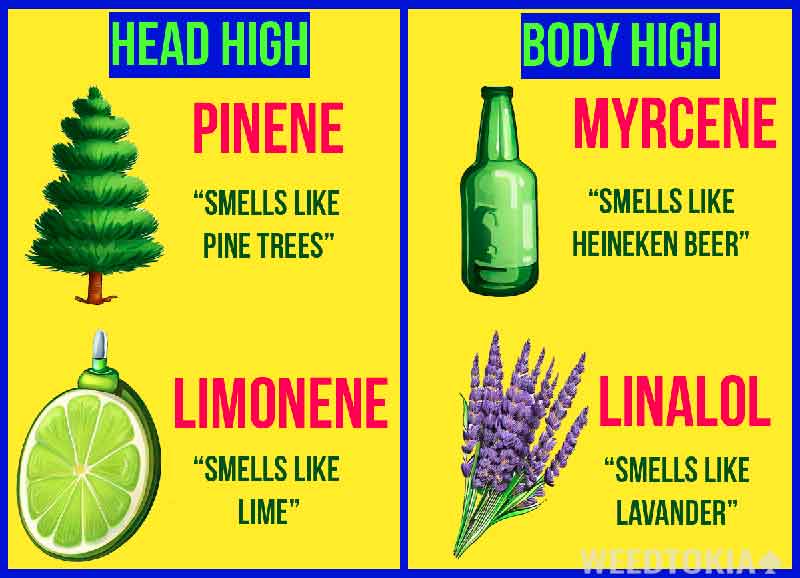
If Sativas and Indicas aren’t good indicators at telling you whether you’re going to have a body high or a head high, then what should we be looking at to predict how a particular strain would affect us?
The short answer: “the terpene profile.” Recognize it by the smell.
- Pinene: This one smells like pine trees and will help you remain focused. It also promotes pain relief and relaxation and helps with memory and breathing. It’s also great as an anti-inflammatory agent and may help stop the spread of bacteria and viruses. If your strain contains a lot of Pinene, you’re most probably going to get a “head high”
- Linalol: This smells like lavender and is great for relaxation, anti-anxiety, and stress relief, and it acts as an anticonvulsant, antidepressant, and muscle relaxer. If your cannabis strain contains a lot of Linalol, you can expect to feel relaxed, but it might not necessarily mean you’re getting a “body high.”
- Myrcene: This one smells like a Heineken tastes, and if you’ve ever smoked a chronic that gives you that “meaty taste,” it’s most probably myrcene. This terpene is great for insomnia, muscle spasms, and pain management. If your weed smells like OG Chronic or Hops, you can pretty much be sure you’re going to experience a “body high.”
- Limonene: It smells like lime and is most likely associated with a “head high.” I’m not going to list too many other benefits since I listed a few above.
While there are plenty of other terpenes to be found in cannabis, the ones listed above play a major role in how your high will develop.
For those uncertain what terpene is, it’s basically what gives plants their smell. They are a group of unsaturated hydrocarbons found in the oils of a plant.
However, this is only a part of the puzzle. Cannabis contains terpenoids, cannabinoids, and flavonoids. These all form part of the more than 400 compounds naturally found in the plant. The combination of all of these creates a phenomenon known as the “entourage effect” or the “net effect.”
The entourage effect is simply that all of these different compounds work in conjunction to generate specific results. This is why a specific extract of a cannabinoid will never be as effective as “whole plant extraction.”

Research at Steep Hill Labs, one of the leading labs to test cannabis and map the genome of the plant, has shed some clarity on what terpene is most likely to produce a specific effect. For example, myrcene, a common terpene found in hops and used in making beer, is also present in cannabis.
Myrcene typically induces a more relaxed, sedative feeling. It’s got a clove-like smell to it and is also a powerful antibiotic, analgesic and anti-inflammatory agent. According to Steep Hills, when a plant has more than 50% presence within the terpenoid profile of the plant, you’re going to experience a “body high.”
Conversely, Limonene, the terpene found in limes and lemons, has a citrus-like aroma. This terpene has a strong antioxidant effect but also seems to be responsible, alongside Pinene, for the “head high.” According to Steep Hills, cannabis containing 50% or more of these terpenes are great indicators that you’ll have an energetic, focused high as opposed to a deep narcotic sensation.
While these are only two of the more common terpenes, the reality is that there are plenty of others present in cannabis. Below you’ll find a quick list of the most common ones and the effects they produce.
While indica and sativa are still used in dispensaries at the time of writing this Weedtokia deep dive, over the coming years, you’ll begin to notice that terpene profiles will take center stage. As more research unlocks the secrets of cannabis, we’ll begin to see “effect-specific” strains developed.
Now that we know the basics of what causes a head high or a body high let’s look at how to use each of these different extremes to our benefit and what potential pitfalls may arise from taking too much.
Ideal Time To Get a Head High?

Let’s take a look at “head highs” for a moment. Head highs are typically associated with “daytime consumption,” meaning with this type of high, you’re in the business of getting things done. You’ll notice a spike of energy and focus; there will be a definite skip in your step.
These kinds of highs are perfect if you have a lot of tasks you’ll want to complete throughout the day and phenomenal if you’re creating art or doing outdoor activities. Strains that give you a head high will be what you’ll want to smoke when going to parties, venues, concerts, and so forth.
If you experience social anxiety, the head high will give you a boost of confidence. These kinds of highs are very pleasurable and are perfect if you’re an active person.
This is also why most people like to use this during the day because they can feel the relaxation of cannabis without feeling the “stoned” effect that some other strains may produce.
However, there are a few downsides to smoking too much “head high strains.”
Negative Effects of A Head High

While it’s true that Head Highs help with social anxiety, confidence, energy, and focus, too much of it can lead to paranoia, lack of focus, and spiked anxiety. It seems like a strange reaction, but many people have reported feeling this way when smoking too much.
This could be due to a high THC presence within the terpene profile. THC is what produces the euphoria associated with smoking cannabis. The terpenes modify this feeling and change it to the desired effect; head high or body high.
When the strain you are smoking contains too much THC, it can act as a catalyst for these negative effects. This is a form of “greening out” or consuming so much weed it’s uncomfortable.
It’s important to know how to counteract these feelings when it happens. The best advice would be to find a quiet place, away from people, and to start deep, slow, and controlled breathing. For example, Box Breathing, where you inhale for 4 seconds, hold for 4 seconds, exhale for 4 seconds and hold for 4 seconds, will help you relax. You can also do slow nasal breathing, simply focusing on the breath to shift your nervous system from “fight or flight” to “Relax and digest.”
Also remember to drink liquids and eat some food to “lower the high”.
Ideal Time To Get A Body High?

For the most part Body Highs are meant to be experienced in a place of comfort. This could be your home, a cabin in the woods, on the beach, or even when you’re going for a massage. Seeing that you’re going to be experiencing an almost “narcotic” sensation, you’ll want to be in a place where you won’t be bothered by others.
This is why people typically use this at night since wanting to sleep is often an effect of consuming strains that induce this effect. However, you can also expect to experience deep relaxation, pain relief, appetite stimulation, and much more.
Typically, people make use of this effect when recovering from injury or if they have an illness of sorts. This is because sleep is one of the fundamental aspects of accelerated healing. Since this effect is all about inducing sleep or providing that narcotic sensation, it becomes a wonderful aid when in recovery.
You won’t be running around when you’re experiencing a body high. It’s more of a “Netflix and Chill” situation. That’s one of the key differences between a head high and a body high. The things you want to do will be vastly different.
Negative Effects of A Body High

As with the “head high,” a body high can go wrong. Fortunately, since cannabis has such a high LD-50 rating, it means that even if you’re greening out, it is virtually impossible to induce a lethal dose. Nonetheless, when you consume a strain that has a high THC presence with terpenes that induce a body high, you may experience extreme drowsiness, cottonmouth, and even mild hallucinations.
It is possible to experience severe hallucinations of cannabis when it is consumed orally. This is because the liver breaks down the THC and converts it to 11-hydroxy THC which is said to be ten times as potent as delta-9-THC (smoked).
If you happen to green out on a “body high strain,” it is recommended that you find a quiet and calm environment. Get some water and lay down flat. Once more, “deep breathing” can significantly help you remain calm and stay focused.
If possible, the best thing you can do is go to sleep. It shouldn’t be too difficult since you’d feel a heavy body sensation. Once more, eating something would help to reduce the sensation of being high; however, unlike a head high, a body high almost always ends up in sleep. Coffee can help to combat the sensation slightly and was mentioned in earlier pharmacopeias as a “remedy for cannabis.”
For both the Body and Head Highs, consuming some CBD will also help counteract the THC in your cannabis since it’s a neuro-controller.
Great Strains To Get A Head High
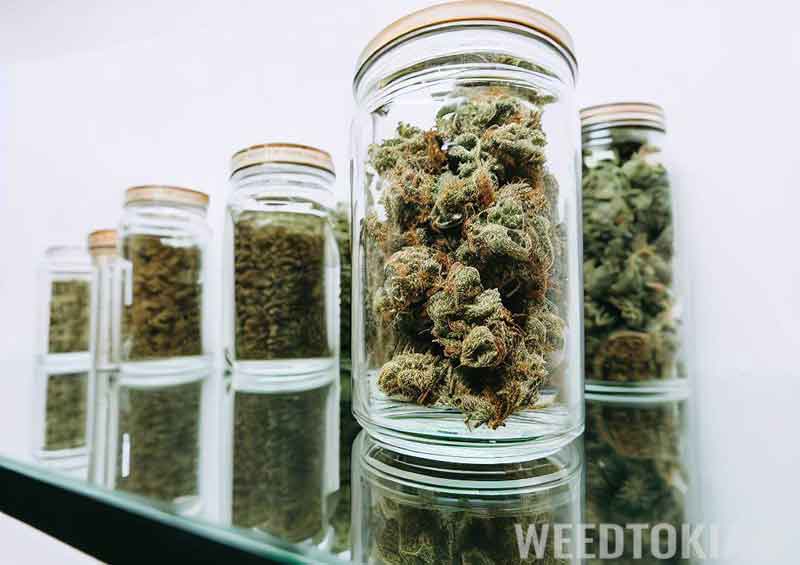
If you’re looking to track down some cannabis to induce a head high, you’ll still have to look in the Sativa section of your local dispensary. You can find any “sativa dominant strain” which should induce the head-high effect.
Traditionally, strains like Jack Herer, Green Crack, Durban Poison, and Strawberry Cough are good options. However, with breeders creating new crossbreeds every year, you could find plenty of strains that fit the profile.
When using your nose, try to sniff out strains that have a high “citrus” and “pine” smell to them. This will indicate high levels of Pinene and limonene, which are both said to help with focus and energy.
Be sure to ask your budtender about the different options available, and if they do have information about the terpene levels in the strain, inquire about those too.
Great Strains To Get A Body High
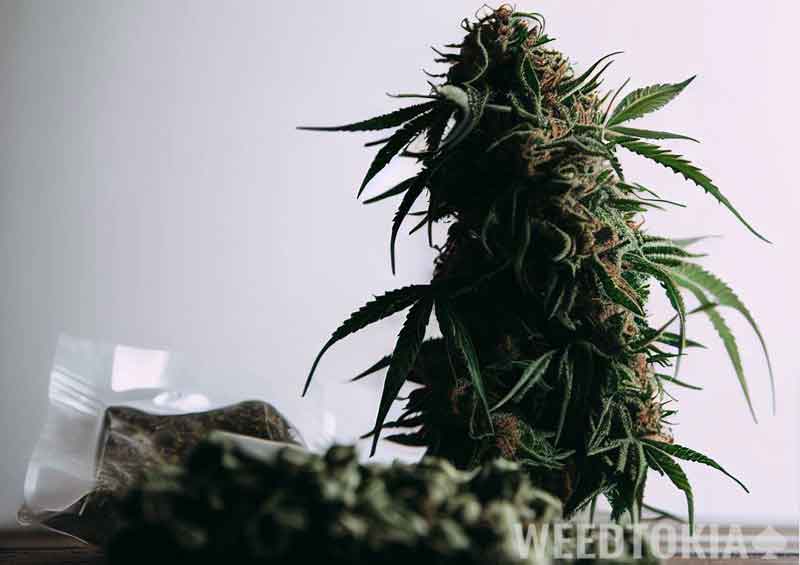
Not everybody wants to get fired up! If you’re looking for a dank body high, any type of Kush typically will do the trick. Other strains include Grape Ape, Harlequin, Girl Scout Cookies, OG Kush, and any variety of indica.
Once more, if you’re going to be using your nose to help you select a strain, you’ll want to look for the myrcene, which smells a bit like cloves or hops.
Be sure to ask your budtender for high “Indica strains” or Indica dominant hybrids. To induce a deep body high, you’re going to want to consume an edible. Just remember, it takes about 45 minutes to an hour before the effect kicks in.
You don’t want to overdose on edibles. Even though it’s highly unlikely that you’d die on a super dose of edibles, many people can’t handle the effects. Just remember to breathe, find a calm, quiet setting and ride it out.
A common expression in the world of psychonauts is, “Whatever goes up must come down!” Make this your mantra as you ride the dragon!
Do Expectations Play A Role In a High?
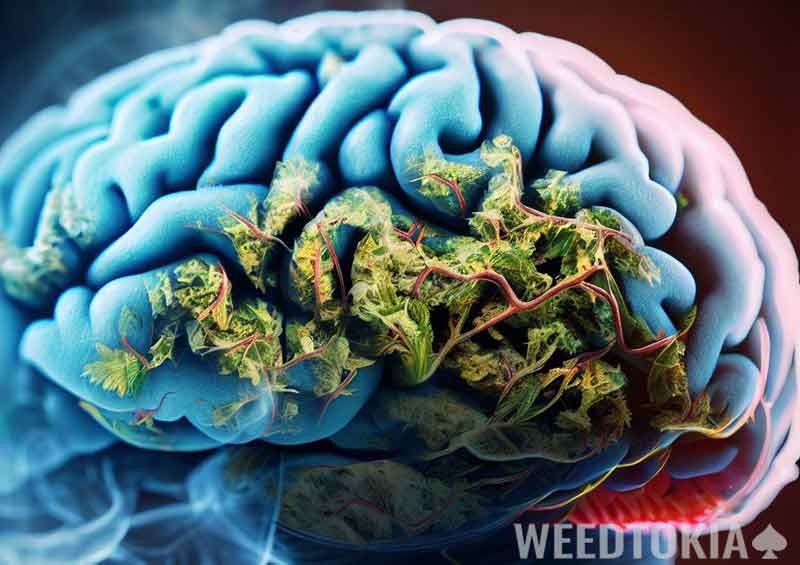
One thing we haven’t spoken about that is worth mentioning is “set and setting,” a term coined by Timothy Leary. In essence, he determined that a drug experience is heavily influenced by the environment and the mindset of the consumer.
In other words, the expectation might play a significant role in the “head high” vs. “body high” experience. If a budtender told you, “Nah dude, this is a spacey strain that will have you floating for hours!” the odds are that you will experience a head high, even if there are high myrcene levels in it.
This is because your mind expects this effect to happen, and as a result, it does!
Of course, any experienced cannabis user will say that there is “some” truth in this statement, but sometimes a strain simply has that “uplifting effect” or that “grounding effect.”
TLDR: Head Highs and Body Highs

- Head highs and body highs are concepts in cannabis euphoria. These are known by regular smokers, and the former is associated with energetic euphoria, while the latter is with relaxation and sedation.
- If it smells like pine trees or lime, expect a head high. If it smells like beer or lavender, expect a body high.
- The belief that sativa strains produce head highs and indica strains produce body highs is not accurate, as terpene profiles play a significant role in determining the effects of a particular strain.
- Terpenes are aromatic compounds found in cannabis that can provide clues about the type of high a strain may produce. For example, strains high in pinene are likely to induce a head high, while those high in myrcene are associated with a body high.
- Your mindset can influence the high experience.
Currently, our understanding of the extremes of a cannabis high is limited. We know that terpenes play an important role in warping the effect of THC. We also know that the terms “sativa” and “indica” fail to provide an accurate description of these experiences.
Over the coming years, as cannabis becomes legal on a federal level, you’ll begin to see additional metrics added to determine the effect of a strain. The terpene profile will become a critical component of the “Strain Fingerprint.” In fact, some dispensaries are already incorporating minor cannabinoids and terpenes within their strain descriptions.

We still have so much to learn when it comes to cannabis, and as we continue to see further acceptance of the plant within society, we can expect to discover more about these peculiar effects.
Feel free to explore the rest of our site and discover more amazing news, articles, facts, tutorials, and deep dives on everybody’s favorite plant, cannabis! We believe that if you are going to consume anything psychoactive, it’s far better to have a firm understanding of its effects.